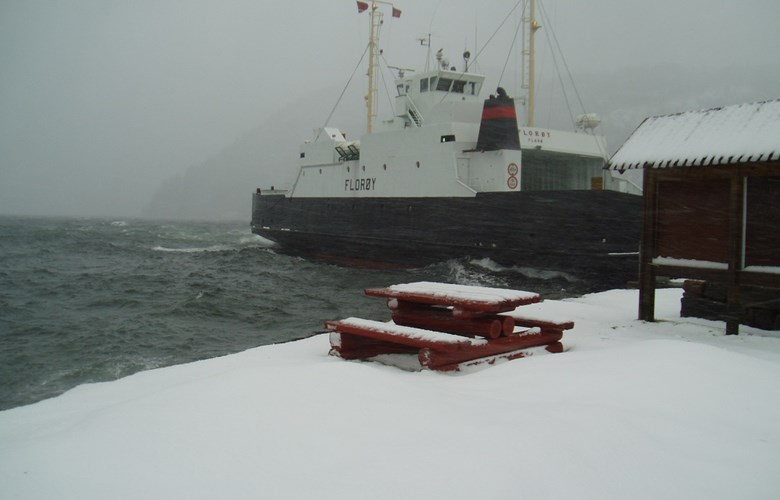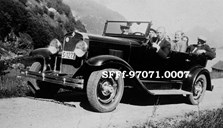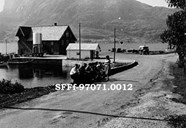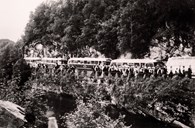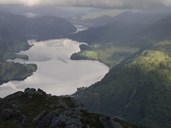Demand for a road around the Dalsfjord
In the 1930s, the road communications in Hyllestad, Askvoll, and Fjaler were debated vigorously. The demand for a continuous road on the north side of the Dalsfjord was put forward by the communications board and the municipal council of Askvoll in 1932. In 1933, Gaular joined in. But Fjaler wanted a ferry from Eikenes to Dale and a road on the south side between Dale and Osen. The question was postponed for more research and pending the "compensation plan" (financial compensation for lack of railway, which never materialized), yet none of the roads were given priority. The Dale-Osen road was included in the budget only in 1938-39.
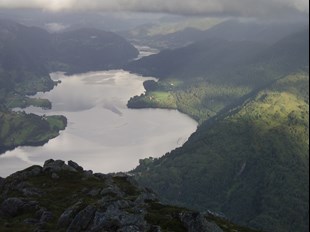
Opposition to ferry
At the same time, the road planning committee at Askvoll and Norges Automobilforbund (NAF) (automobile association) advocated a connection across the Dalsfjord, which would connect Askvoll to Dale with a ferry between Eikenes and Dale. But there were opponents of the ferry connection as well. They feared that a ferry connection would slow the work for a road between Dale and Osen. A number of people believed that a ferry connection would be a loss-making project. Nevertheless, the ferry was put in business in 1937, sailing only during the summer months.
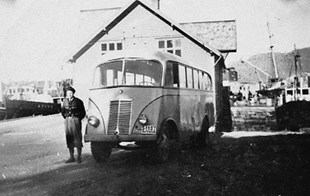
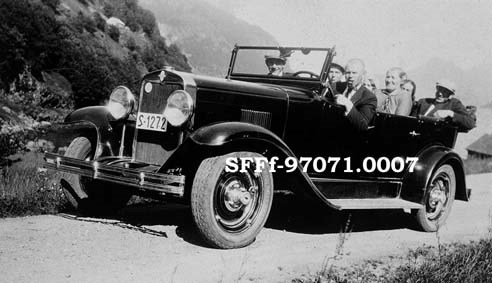
Competition
The traffic was light in the first period. Few people had a car, and the connecting roads were short. On the north side of the Dalsfjord, there was a road from Askvoll to Eikenes with a side road between Holmedal and Straumen. The road on the south side of the fjord between Dale and Leirvik was improved in the 1930s. The ferry now sailed in a triangle between Eikenes, Dale, and Bygstad. The "Fagervik" was the name of the first boat, which was a fishing vessel. It was a private business operated by Jonas Jensson Haugland. Fylkesbaatane (steamship company) started up a competing boat between Dale and Eikenes.
The "Varden" II for nine years
During the war, most ferry services came to a stop. Only in 1949 was the ferry traffic on the Dalsfjord resumed, now by Fylkesbaatane. The first few months 1000 passengers, 30 cars, 25 motorcycles, 120 bicycles were transported. Still the ferry operated only during the summer months, and Fylkesbaatane rented vessels, such as the "Dagning", the "Kvikk" 4, the "Førdefjord", the "Vesle Øyvind", and the "Thorsnes". In 1952, the brothers Ola and Mads Halsnes took over, with the fishing vessel "Varden" II. The mast was taken down, and there was room for four cars. The "Varden" II was in regular service for nine years, all year around.
New ferries
After 1958, when the road Dale-Osen was finished, the ferry crossed between Eikenes and Dale only. Still, the ferry stopped at Standnes in the eastern Dalsfjord, but with fewer crossings. In 1961, the ferry MF "Vangsnes" was put in service on the Dalsfjord. In 1962, the MF "Sogn" took over. Both of these ferries could transport 15-16 cars. The "Sogn" plied the Dalsfjord for 14 years.

Dangerous ferry quays
The old ferry quays were not good enough as traffic increased. It was contended that the quay at Eikenes was so small that it was a wonder no accidents had happened. The newspaper Firda wrote in 1960: "When the ferry brought some cars, and some passengers wanted to get ashore, the word chaos is too weak. The cars had to back up, turn, and crawl by inches on to the quay, while people ran between the cars as if none knew where they were going. That no accidents have happened on the quay is more than a wonder." In 1962, new ferry quays were built at Eikenes and at Dale.
The traffic
From 1960 until 1970, the car traffic on the ferry crossing Dale-Eikenes increased from 1,700 cars to 14,904 per year. The ferry traffic increased as more people had a car. The restriction on the sale of cars was lifted from 1960. In 1980, the ferry transported 17,530 cars, in 1990 21,964. In 2005, the traffic slowed, to 18,000 cars and 42,000 passengers.

